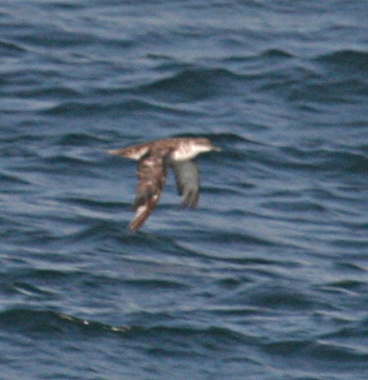Yelkouan Shearwater (Puffinus yelkouan) - Wiki Yelkouan Shearwater
From Wikipedia, the free encyclopedia
Order: Procellariiformes
Family: Procellariidae
Synonyms
- Procellaria yelkouan Acerbi, 1827
- Puffinus puffinus yelkouan
- Puffinus yelkouan yelkouan
[Photo] Yelkouan Shearwater (Puffinus yelkouan), TURQUIA. Source: Flickr (www.flickr.com/photos/jmuchaxo/1717435809/). Date: October 3, 2007. Author: Muchaxo (www.flickr.com/photos/jmuchaxo/).
The Yelkouan Shearwater or Levantine Shearwater (Puffinus yelkouan) is a medium-sized shearwater in the seabird family Procellariidae. It was formerly considered a subspecies of the Manx Shearwater (Harrison 1988); see there for more on the Puffinus puffinus superspecies. After the first split (Sibley & Monroe 1990), it was the nominate subspecies of the so-called "Mediterranean Shearwater" for nearly ten more years; it is considered a monotypic species nowadays, as the Balearic form mauretanicus has been separated as Balearic Shearwater (Wink et al 1993, Heidrich et al 1998, Sangster et al. 2002).
It appears to belong to a group of Mediterranean and adjacent Atlantic shearwaters which includes the Balearic Shearwater (Austin 1996) and one to three prehistorically extinct taxa, Hole's and possibly also Olson's Shearwater and an undescribed form of unclear distinctness from Menorca (Alcover 2001). The two living Mediterranean lineages had probably separated before the end of the Pliocene (c.2 mya), as indicated by molecular differences and putative direct ancestor of the Balearic Shearwater, the Ibizan fossil Puffinus nestori from the Late Pliocene or Early Pleistocene (Heidrich et al. 1998).
This species breeds on islands and coastal cliffs in the eastern and central Mediterranean. Most winter in that sea, but small numbers enter the Atlantic in late summer. This species nests in burrows which are only visited at night to avoid predation by large gulls.
Yelkouan Shearwaters are 30-38 cm long, with a 76-89 cm wingspan. It has the typically "shearing" flight of the genus, dipping from side to side on stiff wings with few wingbeats, the wingtips almost touching the water. This bird looks like a flying cross, with its wing held at right angles to the body, and it changes from very dark brown to white as the dark upperparts and paler undersides are alternately exposed as it travels low over the sea.
The Yelkouan Shearwater has a more contrasted appearance than the Balearic Shearwater with which its winter range overlaps, since the latter species is brown above and dirty white below. It is very similar to the black-and-white Manx Shearwater of the Atlantic, and stray birds out of their usual range are very difficult to identify with certainty.
Also, at least one mixed breeding colony of the Yelkouan and the Balearic Shearwater exists on Minorca. A study of these birds recommended that a combination of morphological characteristics and DNA sequence data should be required at least for scientific purposes to assign individual birds to either species (Genovart et al. 2005). The same study concluded that at least in these westernmost birds, genetic variation was extremely low, suggesting that the Yelkouan Shearwater may have suffered a marked population decline historically and thus, while not threatened judging from its absolute numbers, could be vulnerable to adverse effects of inbreeding.
This is a gregarious species, which can be seen in large numbers from boats or headlands, especially on in autumn. It is under some threat from the development of holiday resorts near its breeding sites, and also from animals such as cats and rats. The Yelkoan Shearwater feeds on fish and molluscs. It does not follow boats.
It is silent at sea, but at night the breeding colonies are alive with raucous cackling calls, higher pitched and more drawn out than Manx Shearwater's.
http://en.wikipedia.org/wiki/Yelkouan_Shearwater
| The text in this page is based on the copyrighted Wikipedia article shown in above URL. It is used under the GNU Free Documentation License. You may redistribute it, verbatim or modified, providing that you comply with the terms of the GFDL. |
